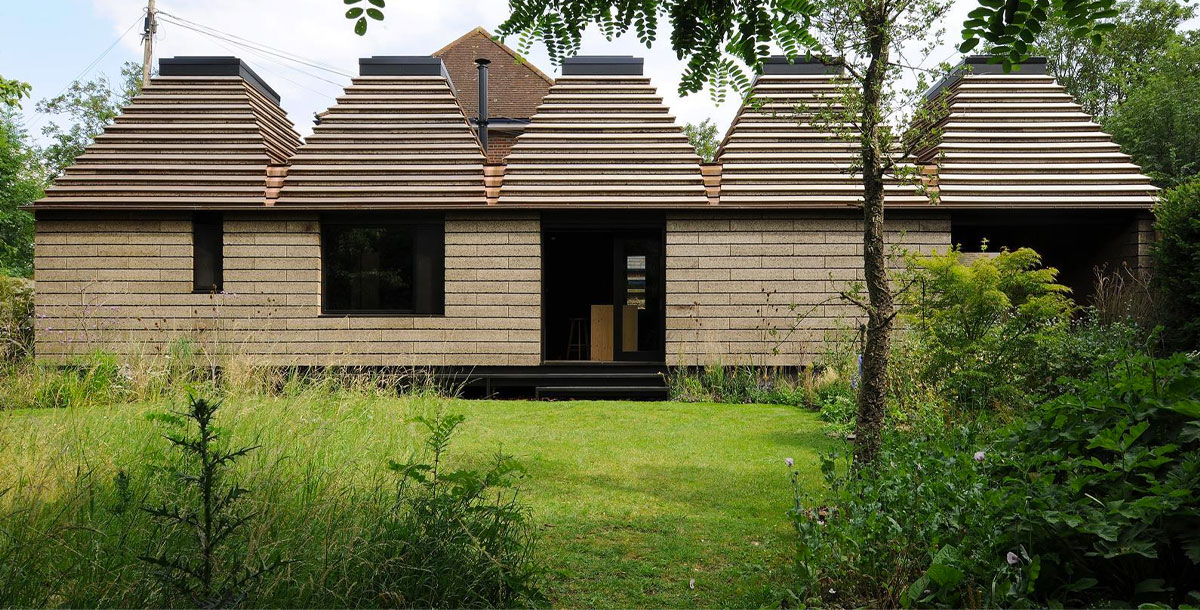How to reduce the carbon footprint of your build
Expert advice to help reduce the impact of your project
Wondering how to reduce the carbon footprint of your self-build? Sustainability and design expert Gary Clark, who chairs the RIBA Sustainable Futures Group and is the regional leader of science and technology at the London studio of global architecture and planning company HOK, share some expert advice.
What contributes to a self-build project’s carbon footprint?
A building’s whole-life carbon, or carbon footprint, is made up of two different types of energy based on the amount of carbon dioxide released into the atmosphere. Firstly, the energy, or equivalent carbon, that’s gone into every aspect of producing the building through to what happens to its physical components at the end of its lifetime. This is known as the embodied energy. Plus, the energy, or equivalent carbon, that will be needed to run it such as the heating and lighting. This is the operational energy. The whole picture needs to be considered, rather than focusing just on the project’s heating requirements or construction materials.
Each component of a building has its own embodied carbon. This is the amount of carbon dioxide that’s emitted during each individual element’s manufacturing process, transportation, maintenance, and eventual deconstruction and disposal. Every detail of the way a product is manufactured will affect its embodied carbon. For instance, a material processed in a factory powered by coal will have a far greater embodied carbon than the same material produced in a factory running on hydroelectric power. Take all of this into account and then you can take decisions to reduce the carbon footprint.
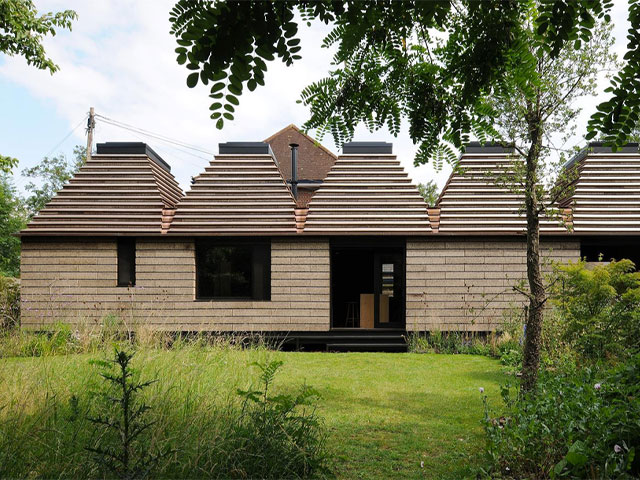
Cork House was built by Matthew Barnett Howland with Dido Milne and Oliver Wilton to explore the possibilities of cork as a structural and insulating material. Photo: David Grandorge
How can I get a carbon footprint estimate?
Product manufacturers may be able to give you an estimate of embodied carbon. You will have to get the information for each element and add them together. Try calculators such as One Click LCA, which can add up all of the energy and convert it to a carbon equivalent. Or you can ask your architect to do this for you. The finished calculation is worked out as CO2 per square metre of floor area. To get an estimate of your operational energy, speak to your architect as this should be factored in at the design stage.’
Is building a home with concrete good or bad?
It depends on the specifics of the build. Concrete has high embodied carbon because of the raw materials it’s made of and the nature of its manufacture. Conversely, it has a high thermal mass, it’s able to absorb the sun’s warmth and release it slowly, keeping room temperatures even and cutting your operational energy down. In certain situations, such as when building a home in a hot climate, the carbon equation may balance out. The Concrete Society’s guidelines suggest replacing cement with ground granulated blast furnace slag (GGBS) or with the lower embodied carbon ingredient of lime. You’d still need to use some cement, though, as full limecrete is still not commonplace enough for engineers and local building standards.

This converted underground reservoir home harnessing the thermal properties of the earth and concrete to reduce energy use. Photo: Andy Haslam
What about wood?
The main thing is to make sure it’s FSC-certified timber. That way, you’ll know that tree was cut down sensitively and replaced by at least two saplings. And do not use wood sourced from old-growth trees. Most of the new-growth forests in Europe and Scandinavia are fine, so check the origin with your timber-frame manufacturer or timber supplier.
Is it better to retrofit a home or build new to a modern energy-saving standard?
Where possible, retrofit first – that is by far the best thing you can do in terms of embodied energy. If the structure is on its last legs and has to be demolished, recover and reclaim anything that can be used again. Architecturally, you can create a bit of character at the same time.
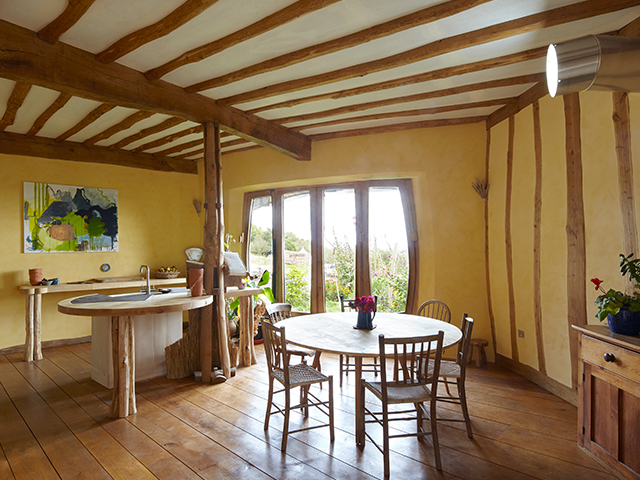
Ed and Rowen Waghorn’s Herefordshire home is made with locally-sourced timber, stone and lime. Photo: Andrew Wall
Which materials lend themselves to salvaging or repurposing?
Anything natural is easier to recycle. Composite materials such as plastics are much harder. Old brick with lime mortar is easy to reclaim. Timber is fine but you need to have it graded to check its strength. This applies to steel, as well. Timber windows and doors can be reused but it’s difficult to do so with plastics or metals. Old metal-frame windows can be installed, but with secondary double glazing for insulation.’
What recommendations do you have for using expanses of glazing?
A general rule of thumb is to keep glazing down to 30 or 40% of the total wall area because there still needs to be a good proportion of solid wall and effective insulation. And apply Passivhaus principles by having any greater expanses of glass facing south, for solar gain, and smaller areas looking north, if you are in the northern hemisphere.
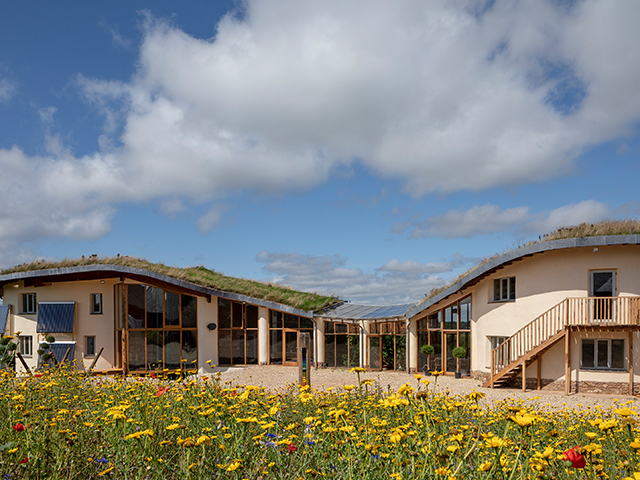
The windows in this impressive east Devon house, made of natural cob, are triple-glazed. Cob can return back to soil at the end of the building’s lifetime. Photo: Mark Bolton
Is there a way to minimise glazing’s carbon footprint?
The future is triple glazing. With double glazing, even when specifying hi-tech coatings and argon fillings you can only get down to about 1.2U-value. U-value is a measurement of insulation performance: the lower the figure, the better the performance. Using krypton, which is really rare and very expensive, will bring the figure down to about 1U-value. Go to triple glazing and you can get down to 0.8U-value with an argon fill. That’s the magic figure, while 1.4 would be the upper limit of what you should be aiming for with glazing. Quadruple glazing might be the tipping point, where the amount of energy used in making it might not be recouped during its lifespan. It would be best to carry out a whole-life carbon analysis if you are planning to use quadruple glazing.
Which natural materials would you recommend?
Recycled paper insulation has been around for 20-odd years. I think it’s great for smaller buildings. The magic ingredient is soaking it in a borax solution, which stops it rotting or the mice eating it. Hemp, when combined with cementitious material such as lime, is also good, and mixtures of rammed earth. Cork is great in terms of insulation, used as wall panels or something like that. Cork House, which was shortlisted for the 2019 Stirling Prize and won the Stephen Lawrence Prize, was a fantastic story, waste cork compacted under great stress to make insulation boards. What’s still experimental is using the material as structural blocks. I’d avoid straw bales, though, as there is a risk of decomposition but it’s possible to control this if you mix it with lime.
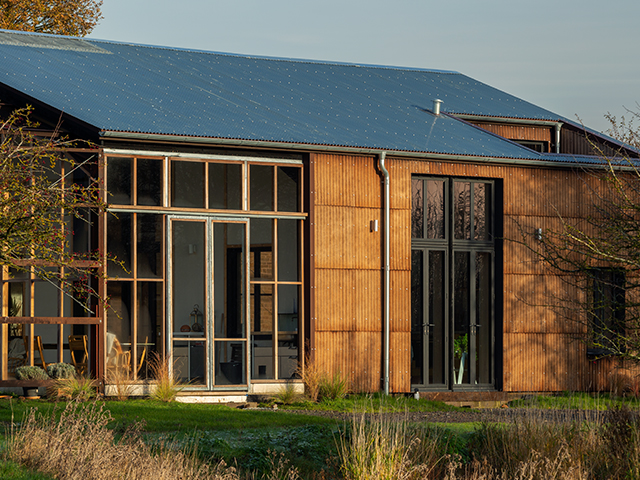
Experimental hempcrete panels were used to clad Margent Farm in Cambridgeshire. Photo: Oskar Proctor
Are self-build homes a good scale at which to experiment with newer construction techniques?
The more experiments the better, but maybe just use it for one wall or a small section. If you are interested doing this, it’s worth approaching your local architecture school, there will always be a member of staff who’s really keen to do research.
If you had to choose one thing to make a difference, what would that be?
In most homes that rely on fossil fuels, heating is the largest contributor to the carbon footprint. It’s down to the really simple things: do as much insulation as you can and build airtight.
USEFUL RESOURCES
These resources offer plenty of useful information about reducing the carbon footprint of a building:
- Green Building Store
- One Click LCA
- The Concrete Society
- RIBA 2030 Climate Challenge; RIBA Sustainable Outcomes Downloadable
- Passivhaus Trust
- UK Hempcrete

